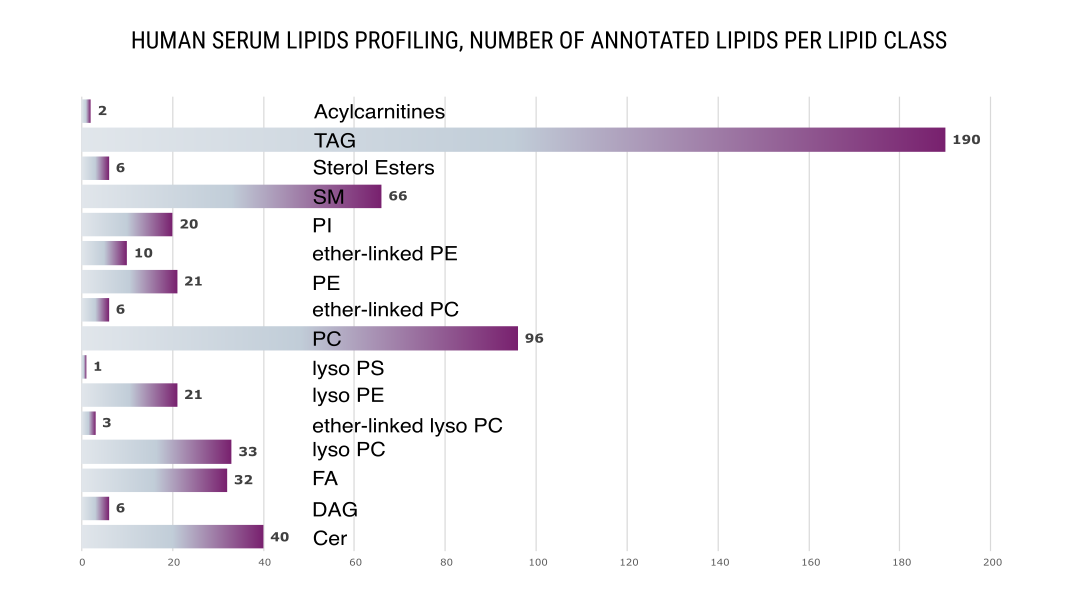Lipidomics Analysis
Lipidomics is a branch of metabolomics that focuses on the comprehensiveanalysis of lipids within a biological system.
Lipidomics is a branch of metabolomics that focuses on the comprehensive analysis of lipids within a biological system. Lipids, which include fats, oils, and hormones, play crucial roles in cellular structure, energy storage, and signaling. Understanding the lipid composition and dynamics in cells, tissues, and organisms is essential for unraveling their roles in health and disease.
At metaSysX, we offer cutting-edge lipidomics services designed to provide detailed insights into the lipid profiles of your samples. Our advanced analytical platforms, combined with our extensive lipid databases and state-of-the-art bioinformatics tools, enable us to deliver high-quality, reliable data for your research needs.
These are 23 lipids classes detectable in metaSysX
Free Fatty acids
FA
Diacylglycerol
DAG
Triacylglycerol
TAG
Phosphatidylcholine
PC
Phosphatidylinositol
PI
Phosphatidylethanolamine
PE
Phosphtidylglycerol
PG
Lysophosphatidylcholine
LysoPC
Lysophosphatidylethanolamine
LysoPE
Lysophosphatidylglycerol
LysoPG
Ether-linked phosphatidylcholine
ePC
Ether-linked Phosphatidylethanolamine
ePE
Ether-linked Lysophosphatidylcholine
eLysoPC
Sphingomyelins
SM
Ceramides
Cer
Hexosylceramide
HexCer
Inositol phosphorylceramide
IPC
Cardiolipins
CL
Sterol Esters
SE
Acyl carnitines
AC
Monogalactosyldiacylglycerols
MGDG
Digalactosyldiacylglycerols
DGDG
Sulfoquinovosyl diacylglycerols
SQDG
Cholic acid, Sphingosine
Key Features of Our Lipidomics Services:
- Comprehensive Lipid Profiling: We identify and quantify a wide range of lipid species, including phospholipids, sphingolipids, glycerolipids, and sterol lipids, among others.
- Advanced Analytical Techniques: Utilizing techniques such as liquid chromatography-mass spectrometry, LC-MS and LC-MS/MS, we ensure precise and accurate lipid analysis.
- Quantitative Analysis: We provide absolute and relative quantification of lipid species, allowing for detailed comparisons across different conditions and treatments.
- Dynamic Lipidomics: Our services include the analysis of lipid changes over time or in response to various stimuli, helping to elucidate dynamic lipid metabolic pathways and their regulation.
- Lipid Biomarker Discovery: We assist in identifying lipid biomarkers associated with diseases, treatments, or specific physiological conditions, aiding in diagnostics and therapeutic development.
- Custom Data Analysis and Integration: Our bioinformatics experts offer tailored data analysis services, integrating lipidomics data with other omics datasets (genomics, transcriptomics, proteomics) to provide a holistic view of the biological system.

After lipids extraction, the samples are subjected to Liquid Chromatography-mass spectrometry measurements which enable separation and subsequent detection of lipids and lipophilic compounds in complex samples in an untargeted manner. To increase the coverage of untargeted lipids profiling, each sample is injected twice and measured in LC-MS positive and negative ionization mode. This leads to one of the most comprehensive lipids annotation world-wide. The data is additionally acquired in LC-MS/MS positive and negative ionization modes.
Our internally developed software for fragmentation spectrum analysis enhances lipid coverage significantly. When combined with annotation using the MetaSysX database, this approach enables the relative quantification of hundreds of lipid species.
MetaSysX untargeted lipidomic analysis by Reverse phase UPLC-FT-MS for detection and relative quantitation of lipophilic compounds and complex lipids. 1.000 to 2.000 features are detected and 300 - 700 unique lipids annotated based on the retention time, exact mass, and/or fragment-ions spectra from MS/MS analysis.
Following lipids classes can be annotated
- Phospholipids: PC, PE, PI, PG, lysoPC, lysoPE, ether-linked PC, PE and LysoPC, CL;
- Glycerolipids: TAGs, DAGs;
- Sphingolipids: Ceramides, HexosylCeramides, Sphingomyelins, Sterol esters, Saturated and unsaturated free fatty acids, acylcarnitines and
- Galactolipids: MGDGs, DGDGs, SQDGs can be relatively quantified.
Applications of Lipidomics:
- Disease Mechanism Studies: Investigate the role of lipids in disease progression and pathogenesis.
- Drug Development: Assess the impact of drugs on lipid metabolism and identify potential lipid-based therapeutic targets.
- Nutr1itional Research: Explore the effects of diet and nutrients on lipid profiles and overall health.
- Personalized Medicine: Develop lipid-based biomarkers for personalized disease prevention and treatment strategies.
- Agricultural Science: Study lipid metabolism in plants to improve crop yield, resistance, and nutritional value.
By leveraging our expertise in lipidomics, metaSysX can help you uncover the critical roles of lipids in your research, driving advancements in health, medicine, and agriculture. Contact us for consultation about a project.
metaSysX has a pipeline which includes extraction of lipids from:
- 50 µl of plasma/serum and other biofluids
- 50 mg of fresh plants (root, leaf, flower) and animal (liver, kidneys etc) tissues
- 2*106 cell cultures
- 25 mg of lyophilized or dry tissues and seeds
- Dry blood spots and skin stripping discs
- Our pipeline can be adjusted to detect lipids from lower amounts of samples.
Get a Quote
